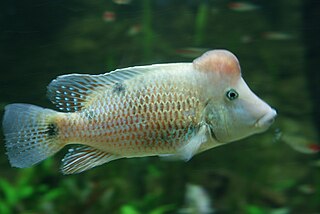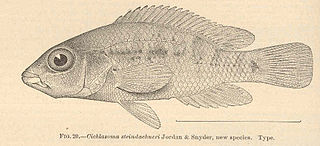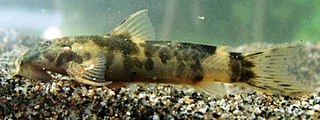
George Albert Boulenger was a Belgian-British zoologist who described and gave scientific names to over 2,000 new animal species, chiefly fish, reptiles, and amphibians. Boulenger was also an active botanist during the last 30 years of his life, especially in the study of roses.

Geophagus is a genus of cichlids that mainly live in South America as far south as Argentina and Uruguay, but a single species, G. crassilabris is from Panama. They are found in a wide range of freshwater habitats. They are part of a group popularly known as eartheaters and mostly feed by picking up mouthfuls of sediment to sift out food items such as invertebrates, plant material and detritus. The largest species reach up to 28 cm (11 in) in standard length. They are mostly kept in aquariums.

Sebastes is a genus of marine ray-finned fish belonging to the subfamily Sebastinae part of the family Scorpaenidae, most of which have the common name of rockfish. A few are called ocean perch, sea perch or redfish instead. They are found in the Atlantic and Pacific Oceans.

Carl Henry Eigenmann was a German-American ichthyologist of the late nineteenth and early twentieth centuries, who, along with his wife Rosa Smith Eigenmann, and his zoology students is credited with identifying and describing for the first time 195 genera containing nearly 600 species of fishes of North America and South America. Especially notable among his published papers are his studies of the freshwater fishes of South America, the evolution and systematics of South American fishes, and for his analysis of degenerative evolution based on his studies of blind cave fishes found in parts of North America and in Cuba. His most notable works are The American Characidae (1917–1929) and A revision of the South American Nematognathi or cat-fishes (1890), in addition to numerous published papers such as "Cave Vertebrates of North America, a study of degenerative evolution" (1909) and "The fresh-water fishes of Patagonia and an examination of the Archiplata-Archelenis theory" (1909).
Nannostomus harrisoni,, is a species of pencil fish. Native to The Guianas, the species displays a single horizontal stripe of intense black, and blood red adornments on its fins. N. harrisoni is often confused with Nannostomus unifasciatus, another long, slender, single-striped species with similar profile and coloration, but N. harrisoni swims in a horizontal posture, as opposed to the snout-up oblique posture of N.unifasciatus, and the bright red adornments on the ventral fins of N. harrisoni are absent in N. unifasciatus. Though the recently described species N. grandis has been dubbed the largest member of the genus, adults of N. harrisoni commonly grow to a length of 70 mm, making it in fact the largest species of pencil fish described to date. It is commonly known as Harrison's pencilfish.

The Redhump Eartheater, Geophagus steindachneri is a species of eartheater cichlid from freshwater habitats in northwestern South America.

Istiblennius is a genus of combtooth blennies found in the Pacific and Indian Oceans. The generic name is a compound noun composed of istio the Greek for "sail", referring to the high dorsal fin of the type species, Istiblennius muelleri, and blennius which is derived from a word for "mucus" and refers to the scaleless bodies that characterise the Blenniidae.
Istiblennius steindachneri is a species of combtooth blenny found in the western Indian ocean. It can reach a maximum of 11 cm (4.3 in) in SL. The identity of the person honoured in this blenny's specific name was not stated by Pfeffer in his description but it is almost certainly the Austrian ichthyologist Franz Steindachner (1834-1919).

Ophioblennius steindachneri, the large-banded blenny or the Panamic fanged blenny, is a species of combtooth blenny found in coral reefs in the eastern Pacific ocean. This species reaches a length of 18 centimetres (7.1 in) SL.
The South American weedfish(Ribeiroclinus eigenmanni) is a species of clinid found along the Atlantic coast of South America from southern Brazil to central Argentina where it has been found at a depth of about 17 metres (56 ft). It can reach a maximum length of 4.4 centimetres (1.7 in). This species is currently the only known member of its genus. The specific name honours the ichthyologist Carl H. Eigenmann (1863-1927).
Carlana is a genus of freshwater fish in the family Characidae. It contains the single species Carlana eigenmanni, which is found in Costa Rica, Nicaragua and Panama. The maximum standard length is 5.4 centimetres (2.1 in).
Hollandichthys is a genus of characins endemic to rivers and streams in southern and southeastern Brazil from Rio Grande do Sul to Rio de Janeiro. These are small fish that reach up to 9.6 cm (3.8 in) in standard length. The currently recognized species in this genus are:

Psellogrammus is a genus of freshwater fish in the family Characidae. It contains the single species Psellogrammus kennedyi, which occurs in Argentina, Brazil, and Paraguay. It is found in the Paraguay and São Francisco River basins.
Gerald Robert "Gerry" Allen is an American-born Australian ichthyologist. His career began in 1963, when he spent a semester at the University of Hawaii, where he also received a PhD in marine zoology in 1971. In 1972, Allen wrote his doctoral thesis on the systematics and biology of the anemone fish.

Nosferatu steindachneri, Steindachner's cichlid, is a species of cichlid endemic to Mexico where it is found in the Tamasopo, Gallinas and Ojo Frio Rivers of the Panuco River basin. It reaches a maximum size of 40.0 centimetres (15.7 in) SL. This species can also be found in the aquarium trade. The specific name honours the Austrian ichthyologist Franz Steindachner (1834-1919).
Parrella is a genus of gobies native to the tropical waters of the Pacific and Atlantic coasts of the Americas. The name of this genus honours the Norwegian American marine biologist, zoologist and oceanographer Albert Eide Parr (1900-1991).

Astroblepus chapmani is a species of catfish of the family Astroblepidae. It can be found in the Magdalena River in Colombia.
Astroblepus eigenmanni is a species of catfish of the family Astroblepidae. It can be found on Ecuador.
Zaniolepis frenata, also known as the shortspine combfish, is a species of ray-finned fish belonging to the family Zaniolepididae.The species occurs in the eastern Pacific Ocean.
Copella eigenmanni is a species of fish in the splashing tetra family found along the Atlantic coast between Pará to Delta Amacuro, the mouth of the Orinoco. They grow no more than a few centimeters.










